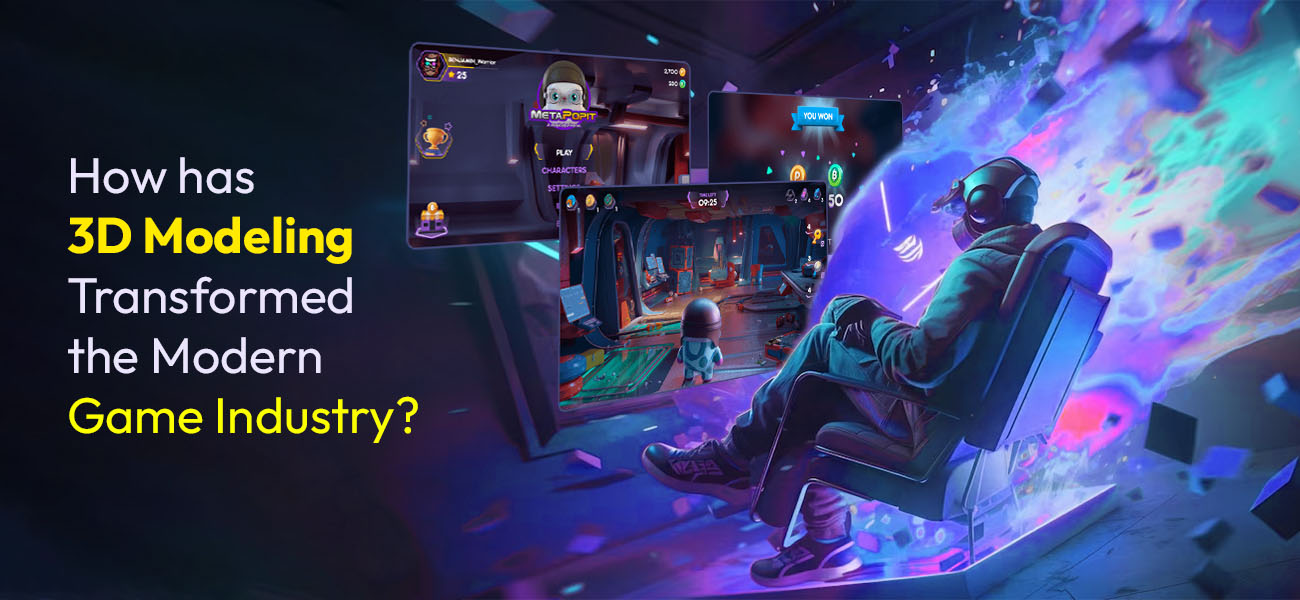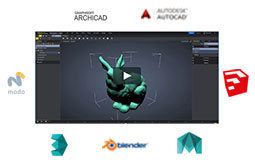How has 3D Modeling Transformed the Modern Game Industry?
Back in the early 90’s, before true 3D games could actually be seen, one video game was a game-changer. The game “Doom”, launched in 1993, spawned several attempts at faking 3D illusions with 2D game assets. It is the massive popularity and craze of this semi-3D game that led to the creation of full-fledged 3D games. Over the years, there have been myriads of R&D in that genre motivated by technological evolution.
Undoubtedly so, 3D modeling has a significant role in it. Simply put, 3D modeling technology has transformed the modern game industry, yielding immersive gaming experiences. The technology has become integral to 3D game development on its own merit.
So, today, this article is going to delve deep into the ways in which 3D modeling has shaped computer games as we see them now and the significance it holds for this rapidly growing sector. We will also explore what the future holds for 3D modeling in CG game development. Let’s begin!

Why is 3D modeling so significant in the gaming industry?
Honestly, 3D modeling benefits is very diverse, among which the most pivotal aspects for computer game developers. This significance is equally spread throughout the production and development stages; right from ideation, conceptualization, and designing the game assets. By creating 3D game props, game designers can breathe life into their creative visions with meticulous control of lighting, camera angles, textures, animations, etc. The models created in 3D space enhance realism as well as immersiveness, which ultimately create high emotional connections in the end users.
Digital modeling is integral for hyper-realistic 3D game characters design having intricate facial details, organic movements, physical simulations, and more. The incorporation of 3D modeling techniques thus transports players into a virtual world of dynamic characters, realistic environments, and detailed landscapes. CG games like GTA San Andreas, Call of Duty, Red Dead Redemption, and Grand Gangster Miami – have become possible to create only because of the technology and its wise integration. The advancements in gameplay mechanics, complex characters flaunting dynamic attributes, and overall heightened user experience are the results of 3D modeling integration.
he incredible significance digital modeling has for the gaming industry doesn’t end here. Game developers can now incorporate unlimited possibilities, perspectives, and depth through role-playing games where the player assumes a role in the game. This unprecedented dimensionality and realism have only been possible since the advent of 3D modeling in gaming.
This remarkable paradigm shift has not just augmented the visual appeal of computer games, but has also opened the scope for virtual reality gaming. 3D technology has welcomed the metaverse, AR, VR, and MR that go beyond the three-dimensions, creating highly immersive virtual worlds. 3D modeling is exceptionally needed for this purpose.
How have 3D models and graphics enhanced and revolutionized modern game development?
Now let’s see how 3D modeling has impacted and revolutionized modern game art development. From the old times of pixelated 2D bitmap graphics, called “sprites”, to the intricately detailed 3D game assets we see today, 3D designs have brought an unparalleled transformation to CG games.
For example, every great video game with role-playing attributes requires improved graphics and high levels of immersion to keep users engaged. Let’s check out to what extent modern video games have been enhanced and transformed by 3D modeling advancements.
The very first stage in the game development process is conceptualization, or ideating the concept art. The aesthetics, visuals, attributes, and other overarching ideas are formulated in this stage. With 3D modeling for games as a tool, game designers can conceptualize the characteristics, facial features, and appearances of each character and create the mood board.
Designing 3D characters with individual personalities and depth of character is another aspect where modeling holds immense value. Based on the storyline and the character’s role in the game, the personality is given. 3D modeling has made possible all the aspects previously unattainable, like emoting a diverse range of facial emotions. The technology is so robust that it enables game designers to sculpt the characters with lifelike levels of detail. This is a commendable transformation from the earlier crude 2D images that could show only a couple of basic emotions.
Creating 3D environments with realism, expansion, and immersion requires the aid of 3D model design. With advanced 3D designing, rendering, and texture mapping techniques, game developers can now create extraordinary virtual worlds, busy downtowns, lush forest areas, savannas, post-apocalyptic ruins, dystopian wastelands, cyberpunk environments, and more.
Fascinating and dynamic light effects with changing weather, mysterious smog, and neon-lit alleyways all teleport players into the game like never before. A perfect example of this is the 2022-released 3D survival game “Stray”, about a cat getting lost in a city, developed by a French game development team. Stray became massively popular upon its release, mostly because of its hyper-realistic murky environments, action-packed sequences, real-life physical simulations, and movements typical of a feline.
While speaking about 3D designs and visualization for game development, game props and objects deserve a worthwhile mention. Every vehicle, tree, weapon, box, building, mountain, barrel, furniture item, street lamp, treasure chest, and even the non-playable characters (NPCs) we see in the games are the fruits of 3D model design. These 3D-designed props enhance the ambiance and create a realistic setting.
Special visual effects, or VFX, are also another aspect where 3D graphics play a pivotal role. These dynamic components include thunder and lightning, fog, smoke, rainfall, snowfall, fireballs, explosions, dissolve, and more such visually captivating actions. 3D models are the core of these phenomena and special effects, while the developer controls the intensity. The result? A mad level of immersion and enthusiasm from the players’ side.
Lastly, in the main part, the 3D character animation has a remarkable impact on connecting with users and gamers on a deeper emotional level. The characters we see onscreen are unbelievably natural, exhibit an extreme range of human emotions, have natural movements, showcase distinct personalities, and more. With facial animation and skin shading techniques, these digital characters are chiselled to a perfect quality.
With 3D motion capture technology, game developers can replicate the real-world expressions of actual actors, physical movement, and gait, thereby incorporating them into the virtual characters.
All of this is done through specialized 3D modeling and sculpting software programs. Some of these games are so well received by the global audience that they have been made into full-length feature films. Namely, Lara Croft, The Witcher, Last of Us, and more.
All that said, 3D game designs and graphics have truly pushed technical boundaries and paved the way for further innovations in modern 3D game development. With cutting-edge software, state-of-the technologies, and high-end rendering engines, it has become easier for game developers to handle complex designs. Representing realistic shadows, reflections, and refractions has become all the more possible with technologies like ray-tracing and path-tracing.
High-fidelity or high-poly and low-poly models optimized for real-time rendering have made the games faster than ever, bridging the gap between real and virtual dimensions. These advancements in 3D modeling and rendering also drive understandable storylines with clear-cut narratives. The models are made in such a way that they complement and enrich the narrative as a whole with increased player engagement.
It is also not just about the appeal or the game's aesthetics. Detailed 3D models have also made way for many other emerging technologies to create an even more immersive gaming experience. Together, the impact and transformation have catapulted the industry’s growth and fandom, driving substantial investments. The coming years will see further improvements in 3D graphics, with countless new opportunities for 3D game developers and modelers.
The future of 3D game artwork: trends and predictions
With increasing technological innovations worldwide, more and more opportunities in 3D modeling for video games are about to happen for sure. Already, we have seen so many advancements in additive manufacturing, a greater focus on sustainable, eco-friendly 3D models, 3D printing, and much more. 2024 and the upcoming years are all set to bring something new to our plate.
Incorporation of AR-VR in the gaming sector has started off late and will flourish further. Demand for detailed AR-VR-compatible 3D models for games has skyrocketed. Besides, with AI (Artificial Intelligence) and ML (Machine Learning) dominating most mainstream domains, CG-gaming is not an exception. With AI-compatible 3D models driven by Machine Learning, gamers can get a taste of much more dynamic and realistic virtual game environments. The emergence of AI-powered 3D modeling software will also enrich and empower the 3D game development process.
Next as we speak is the introduction of “Procedural Generation”, which is a technique that creates diverse virtual game environments with minimal manual asset design. The technique leverages algorithms and codes that generate detailed 3D assets in seconds. This promptly reduces manual efforts in creating complex and vast 3D models, resulting in infinite possibilities and custom user experiences.
Speaking of trends in 3D visualization or rendering, we can see the advent of “Sub-surface Scattering”, a high-end rendering technique that simulates real-world light behavior. As in, the process simulates the interaction of light with translucent materials like leaves, human skin, wax, etc., just as it happens in the real-world.
In a similar way that light penetrates these materials in real life, sub-surface scattering rendering helps game designers achieve such hyper-realism. As a result, the 3D models in the games appear to be hyper-realistic with high visual fidelity.
Retro-inspired 3D models will see a rise, evoking nostalgia and paying homage to the iconic bitmap eras. This trend is purely driven by the visual aesthetics of games from the 80s or 90s, when 8-bit and 16-bit games were played on Atari and Nintendo consoles. The modeling techniques will generate similar gameplay mechanics and art style forms - namely, pixel art and blocky models.
The former art style uses individual pixels for designing the game environments, props, objects, characters, etc. To pay tribute to the look and feel of the games from the by-gone eras, some modern CG games incorporate pixel-art inspired models and textures merged with 3D-generated assets.
The other style-form is blocky models, which are also retro-inspired, seen in games like Minecraft, Pixel Dungeon, Crossy Road, Pew Pew, and the like. These games intentionally use low-poly models and simple geometric, blocky shapes similar to the aesthetics of these early computer video games.
Conclusion
Hope by now you have understood the ways 3D modeling has transformed and revolutionized the modern gaming industry. On the whole, the technology has played a great role in shaping modern video games as we know them today. Be it the highly detailed environments, the hyper-realistic characters, organic movements, physical simulations, stunning lighting, or the special effects, it is 3D that is behind all of these.
The impact of 3D graphics and its artistic potential will keep growing as the years go by. With that, more and more career scopes will also open up for aspiring 3D artists, and demand for skilled 3D modelers will also rise. Software programs required for the job will also see further advancements with new technological add-ons, such as AI and the metaverse, bringing unbelievable visual realism to computer games.
To cater to Gen Zs and Gen Alphas, further new 3D modeling and rendering techniques will be introduced by game developers. The multi-faceted uses of 3D modeling in the gaming industry will see unprecedented growth and unique gaming interfaces and user experiences replete with immersion and interactivity.
So, if you are a game developer and looking for ways to give your customers an unforgettable gaming experience, collaborate with a professional team that offers stellar 3D design services. These expert 3D modeling service providers are backed by experienced professionals who can make your games appear more realistic and immersive. Hire such a company and embrace the limitless potential of 3D graphics and designs for your game projects. Good luck!




